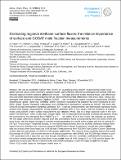| dc.contributor.author | Fraser, A. | |
| dc.contributor.author | Palmer, Paul I. | |
| dc.contributor.author | Feng, L. | |
| dc.contributor.author | Boesch, H. | |
| dc.contributor.author | Cogan, A. | |
| dc.contributor.author | Parker, R. | |
| dc.contributor.author | Dlugokencky, E. | |
| dc.contributor.author | Fraser, P. J. | |
| dc.contributor.author | Krummel, P. B. | |
| dc.contributor.author | Langenfelds, R. L. | |
| dc.contributor.author | O'Doherty, Simon | |
| dc.contributor.author | Steele, L. P. | |
| dc.contributor.author | van der Schoot, M. | |
| dc.contributor.author | Weiss, R. F. | |
| dc.contributor.author | Prinn, Ronald G. | |
| dc.date.accessioned | 2013-08-30T14:40:09Z | |
| dc.date.available | 2013-08-30T14:40:09Z | |
| dc.date.issued | 2013-06 | |
| dc.date.submitted | 2013-04 | |
| dc.identifier.issn | 1680-7324 | |
| dc.identifier.issn | 1680-7316 | |
| dc.identifier.uri | http://hdl.handle.net/1721.1/80325 | |
| dc.description.abstract | We use an ensemble Kalman filter (EnKF), together with the GEOS-Chem chemistry transport model, to estimate regional monthly methane (CH[subscript 4]) fluxes for the period June 2009–December 2010 using proxy dry-air column-averaged mole fractions of methane (XCH[subscript 4]) from GOSAT (Greenhouse gases Observing SATellite) and/or NOAA ESRL (Earth System Research Laboratory) and CSIRO GASLAB (Global Atmospheric Sampling Laboratory) CH[subscript 4] surface mole fraction measurements. Global posterior estimates using GOSAT and/or surface measurements are between 510–516 Tg yr[superscript −1], which is less than, though within the uncertainty of, the prior global flux of 529 ± 25 Tg yr[superscript −1]. We find larger differences between regional prior and posterior fluxes, with the largest changes in monthly emissions (75 Tg yr[superscript −1]) occurring in Temperate Eurasia. In non-boreal regions the error reductions for inversions using the GOSAT data are at least three times larger (up to 45%) than if only surface data are assimilated, a reflection of the greater spatial coverage of GOSAT, with the two exceptions of latitudes >60° associated with a data filter and over Europe where the surface network adequately describes fluxes on our model spatial and temporal grid. We use CarbonTracker and GEOS-Chem XCO[subscript 2] model output to investigate model error on quantifying proxy GOSAT XCH[subscript 4] (involving model XCO[subscript 2]) and inferring methane flux estimates from surface mole fraction data and show similar resulting fluxes, with differences reflecting initial differences in the proxy value. Using a series of observing system simulation experiments (OSSEs) we characterize the posterior flux error introduced by non-uniform atmospheric sampling by GOSAT. We show that clear-sky measurements can theoretically reproduce fluxes within 10% of true values, with the exception of tropical regions where, due to a large seasonal cycle in the number of measurements because of clouds and aerosols, fluxes are within 15% of true fluxes. We evaluate our posterior methane fluxes by incorporating them into GEOS-Chem and sampling the model at the location and time of surface CH[subscript 4] measurements from the AGAGE (Advanced Global Atmospheric Gases Experiment) network and column XCH[subscript 4] measurements from TCCON (Total Carbon Column Observing Network). The posterior fluxes modestly improve the model agreement with AGAGE and TCCON data relative to prior fluxes, with the correlation coefficients (r[superscript 2]) increasing by a mean of 0.04 (range: −0.17 to 0.23) and the biases decreasing by a mean of 0.4 ppb (range: −8.9 to 8.4 ppb). | en_US |
| dc.description.sponsorship | NASA Upper Atmospheric Research Program | en_US |
| dc.language.iso | en_US | |
| dc.publisher | Copernicus GmbH | en_US |
| dc.relation.isversionof | http://dx.doi.org/10.5194/acp-13-5697-2013 | en_US |
| dc.rights | Creative Commons Attribution 3.0 | en_US |
| dc.rights.uri | http://creativecommons.org/licenses/by/3.0/ | en_US |
| dc.source | Copernicus | en_US |
| dc.title | Estimating regional methane surface fluxes: the relative importance of surface and GOSAT mole fraction measurements | en_US |
| dc.type | Article | en_US |
| dc.identifier.citation | Fraser, A., P. I. Palmer, L. Feng, H. Boesch, A. Cogan, R. Parker, E. J. Dlugokencky, et al. “Estimating regional methane surface fluxes: the relative importance of surface and GOSAT mole fraction measurements.” Atmospheric Chemistry and Physics 13, no. 11 (June 13, 2013): 5697-5713. | en_US |
| dc.contributor.department | Massachusetts Institute of Technology. Center for Global Change Science | en_US |
| dc.contributor.mitauthor | Prinn, Ronald G. | en_US |
| dc.relation.journal | Atmospheric Chemistry and Physics | en_US |
| dc.eprint.version | Final published version | en_US |
| dc.type.uri | http://purl.org/eprint/type/JournalArticle | en_US |
| eprint.status | http://purl.org/eprint/status/PeerReviewed | en_US |
| dspace.orderedauthors | Fraser, A.; Palmer, P. I.; Feng, L.; Boesch, H.; Cogan, A.; Parker, R.; Dlugokencky, E. J.; Fraser, P. J.; Krummel, P. B.; Langenfelds, R. L.; O'Doherty, S.; Prinn, R. G.; Steele, L. P.; van der Schoot, M.; Weiss, R. F. | en_US |
| dc.identifier.orcid | https://orcid.org/0000-0001-5925-3801 | |
| mit.license | PUBLISHER_CC | en_US |
| mit.metadata.status | Complete | |
